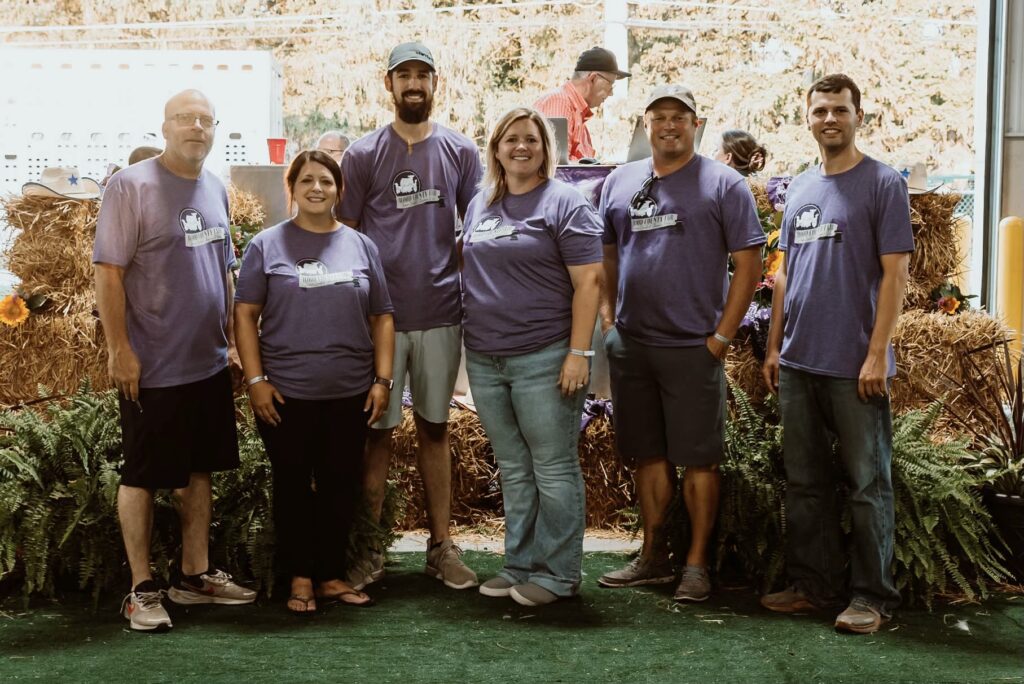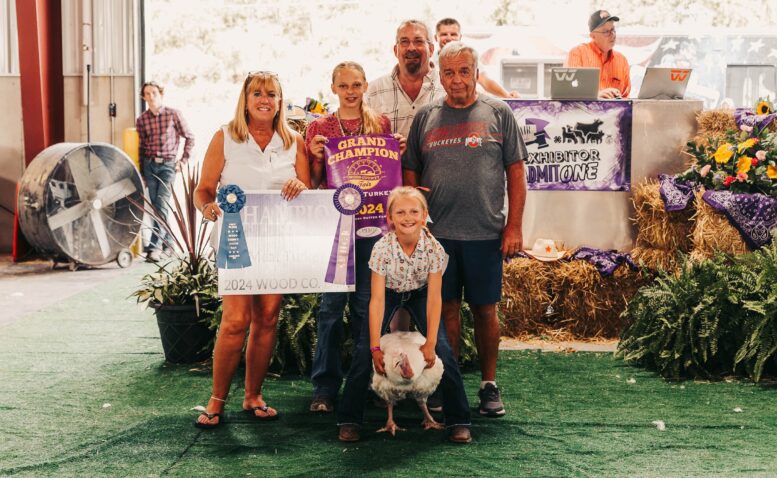By JULIE CARLE
BG Independent News
The Wood County Junior Fair Livestock Showcase and Sale is the grand finale for 4-H and FFA members who show market livestock at the Wood County Fair.
The 2024 end-of-the-fair livestock sale raised more than $340,000, besting the previous year’s total by nearly $16,000, said Amanda McDowell, one of the four non-Fair Board members who serve on the showcase and sale committee.
This year the average amount raised per youth in the online portion of the sale was $962.74, up from $787 in 2023 and $680 in 2022, and almost $370 more than in 2018 when the sale was conducted in person over two days of the fair.
The pandemic changed the format but not the goal of the sale: to support the work and skills of the junior fair youth who show livestock at the fair, said Stacie Anderson, another non-Fair Board committee member.
The post-Covid format – a showcase and sale – was introduced in 2021. It followed the pandemic year when spectators for the livestock shows were limited to immediate family, and the sale was completely online.
“Let’s not go back to what we did before, but let’s find something that works to move forward,” Anderson said about the decision to change the sale format after 2020.
The committee sought input from all stakeholders in the process, from the youth and their families, the extension office and fair board, and the buyers and other sponsors, McDowell said.
Because people liked the online portion of the sale, the committee opted to try a hybrid model that offered a much shorter live auction and a robust online auction.
“We trimmed it down from a half-day small animal sale and full-day large animal sale to about two and a half hours,” Anderson said. “We really wanted to make it not just a sale but an event where you could attend, interact with people and have an elevated experience.”
The format is less stressful and more profitable for the livestock exhibitors and less of a time commitment for the buyers.
“For the livestock kids, showing their animals at the fair and selling them is their Super Bowl,” Anderson said. “No one works harder than these kids. Some of them are investing 12 months in their projects. It is not just the animal, they complete a record book, interview and skillathon. It’s a commitment that should be rewarded,” Anderson said.
The goal of the new sale format focuses on those commitments.
The revamped sale includes the in-person event where the grand and reserve champions and also the showmanship winners have their time in the sale ring.
“We hadn’t included the showmanship winners before, but we wanted to reward them for the extra time they put in with their animals,” Anderson said. The showmanship winners from all of the junior fair showmanship contests have the opportunity “to come in, one by one, be introduced with their names and photos on the screens” as part of the live auction.
The showmanship winners go beyond the market animals and include the showmanship sweepstakes champion and top showmen for non-market dairy goat, dairy cattle, and horse versatility.
A new addition to the sale is called the “final lot” sale, which the committee started after someone mentioned that youth who never win the top awards would never have the opportunity to participate in the live sale, Anderson said.
The committee came up with the idea to invite exhibitors who are showing for their final year of eligibility to participate. They are the last group in the auction and they split the total amount of the final bid in the sale.
This year the live auction included 51 total lots that were finished in under three hours, McDowell said.
The other part of the sale is the online premium sale. All the market animal exhibitors who complete their projects and exhibit at the fair have the opportunity to earn over and above the market price.
Format benefits exhibitors and buyers
And everybody wins under this format, Anderson pointed out. Each junior fair market animal exhibitor can have a personal profile in the online sale that includes a photo and information about the exhibitor and their projects.
This year’s sale benefited from the partnership with Breeder’s World, an online livestock business out of Bellevue, Ohio. The company helps fairs with the process from uploading the youth projects that will be sold during the fair’s junior fair auction to the collection of funds from the buyers.
Previously much of the livestock sale work was handled through the committee and the fair office.
“The partnership with Breeders World allowed us to focus on what we are good at, which is building those connections and working the event to benefit the kids. We didn’t have to worry about registering the buyers or collecting the money,” Anderson said.
The feedback about the process has been positive. Money was collected in a more efficient process and checks will be issued more quickly than in previous years.
“That’s huge for these kids who are already starting to go out and invest in future projects this fall,” she added. “We try to go out and get as much as we possibly can for the kids.”
The buyers know that and are on board with that goal.
Previously, the live auction was dependent on one buyer per lot. Bidders were competing against one another. The new format allows the buyers to spread their allotted budgets across multiple exhibitors.
Some of the traditional supporters are happy with the new format. They no longer have to sit through an all-day auction, said Kip McDowell, the fair board director who chaired the sale committee. “They also are able to reach more kids. They know their budget and can spread their money to more kids.”
Anderson, who manages six counties at Legacy Farmers, said, “We are able to touch many more kids, which is why that average amount goes up.”
In previous years, she was able to buy 16 to 18 exhibitors’ animals. “This year I put money on 42 kids, $50-$100 more per kid, with almost the same budget.”

One of the biggest advantages of the online format is that “we reach more people,” said Kip McDowell. “Grandma and grandpa can now contribute, and every little bit counts for the kids.”
With the online platform, contributions were made from aunts, uncles and businesses from more than 10 states.
Community supports the kids
Asking the local community to support the junior fair livestock sale is an easy sell. Anderson said. “When we say, ‘We need your help,’ they say ‘yes,’” Anderson said.
Top-tier buyers spend between $3,000 and $20,000 each year at the sale because “they understand what we are trying to accomplish,” said Amanda McDowell.
“They get satisfaction in knowing they made an investment and a difference in those kids’ lives,” Anderson added. “It’s not a charity auction where they get tickets to a game or a trip, they just believe so much in what they are accomplishing for the kids.”
A boon to the senior fair board
The new system also benefits the senior fair board. Prior to 2020, the fair board spent up to about $5,000 to run the auction, Anderson said. They would hire a company to clerk the sale, provide refreshments, and print the program.
One of the committee’s goals was to find a way “to leverage our community and business relationships so there is no cost to the fair,” she said. “Indirectly, they were charging the kids because those costs were taken out of the money they get at the end of the sale.”
Every year the committee has managed the sale, they have done it at no cost to the fair. In fact, “we have actually given money back to them,” she said.
According to McDowell, the sponsorship group, flanked by F&M Bank, Rudolph Libbe, A-Gas, Farm Bureau, Murphy Tractor and Wood County Hospital, contributed $6,500.
“We’ve had some great folks step up to help to cover costs for food, drinks, flowers, banners and backdrop, and auctioneer thank yous, at no cost to the fair,” she said. “We are proud that we’ve been able to accomplish that,” though it is a year-round effort that starts as soon as the fair is over.
Other 2024 committee members included senior fair board directors Justin Barndt, Deanne Corken, Doug Michaelis, Brad Hannan and Paul Perry; junior fair committee members Wesley Kellermeier, Emma Meek, Logan Perry, Chloe Heldman and Riley Burtchin; and non-board members Jake Sautter and Drew Baus.

